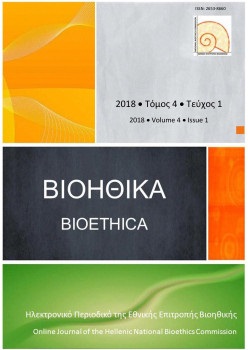CRISPR/CAS and interventions in the human genome: on nature and vice
Abstract
Biological sciences are progressing rapidly. New methodologies of data analysis are necessary due to methods of production of mass biological data. However, new challenges have arisen concerning the knowledge management and its probable bioethical consequences on living beings.
The next step in biological sciences' advancement was the CRISPR/Cas9 method which made possible the selective genomic modification. This method is simple, effective and flexible and facilitates the genomic modification of any organism included human. It is the most impressive achievement on the path of constant advancement in biological engineering technology over the last decade. Although already widely applied in all species, it is its application on human beings that is most interesting. In literature, there is an intense debate and the new technologies are being compared to old eugenics, which gives a negative tone to these methods. On the other hand, there is the optimistic aspect which considers these methods as life-saving for human evolution. This paper aims to present and support the view that the moral value of things is not in nature but in user's habit; to give grounds for more reflection, to discuss bioethical issues arising from the application of this technology and of course to highlight that whatever the upcoming developments of genomic are, they should foster and benefit the individual.
Moreover, it is essential that the scientific community is in a constant and continuous consultation with society at large. Finally, new policies and updated guidelines are of utter importance in order to ensure the respect of human existence.
Article Details
- How to Cite
-
Χασαπάκου (Dionysia Chasapakou) Δ., Προϊκάκη (Stella Proikaki) Σ., Μπόμπολα (Maria Bobola) Μ., & Λάμπρου (George Lambrou) Γ. (2018). CRISPR/CAS and interventions in the human genome: on nature and vice. Bioethica, 4(1), 28–39. https://doi.org/10.12681/bioeth.19696
- Section
- Original Articles
Authors who publish with this journal agree to the following terms:
- Authors retain copyright and grant the journal right of first publication with the work simultaneously licensed under a Creative Commons Attribution CC BY 4.0 License, which allows for immediate free access to the work and permits any user to read, download, copy, distribute, print, search, or link to the full texts of articles, crawl them for indexing, pass them as data to software, or use them for any other lawful purpose. Appropriate credit must be given by citing the author(s) and the original publication in this journal.
- Authors are able to enter into separate, additional contractual arrangements for the non-exclusive distribution of the journal's published version of the work (e.g. post it to an institutional repository or publish it in a book), with an acknowledgement of its initial publication in this journal.
We encourage authors to deposit their articles, as well as data underlying the publications, in institutional and/or other appropriate subject repositories.
Bioethica permits and encourages authors to archive the final publication pdf in institutional (e.g. the repository of the National Hellenic Research Foundation) or other appropriate subject repositories (e.g. SSOAR repository for social sciences), in compliance with institutional and/or funder open access policies, after publication in the BIOETHICA. Authors must provide bibliographic details that credit publication in the journal, as well as related funding details (when applicable).
Lists of institutional and other subject-based academic open access repositories can be found listed by country at the registry http://opendoar.org/countrylist.php
If your institution does not possess a repository you may deposit a copy of your paper at no cost with www.zenodo.org , the repository supported for open access research in the EU by the European Commission, through the project OpenAIRE (www.openaire.eu )



